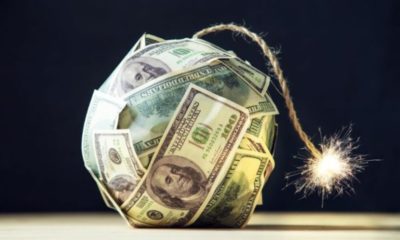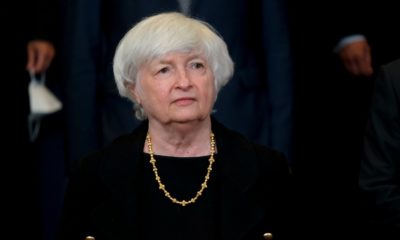Business
Borrowing Back On The Menu for U.S Politicians

The amount of borrowing the U.S. economy relies on has always been huge.
Treasury bonds are astronomical in total value, and many have been calling for slashing the cost of borrowing for years.
However, recently the argument has turned from one of cutting to one of accommodating.
Read on for more.
Reduce spending? Carry on
Whoever wins the election this year, be it, Trump or Clinton, don’t expect either candidate to have an appetite for an agenda of cutting public borrowing.
For several reasons, the agenda is now how American can best take advantage of its increased leverage in the loan.
– Demand for Treasuries means more borrowing available, thanks to strong U.S. performance
– Low-interest rates worldwide mean cheap money
– Deficit has been cut, and recent economic data is propitious
With weak economic growth in Europe, the U.S. stock market is seeing record gains and demand for Treasuries has skyrocketed.
With this, the USA can now borrow more as confidence in its economy is extremely high compared to other OECD nations.

At certain points, there has been debate over who can best strike a grand bargain, to slash the debt which stands as the highest among those in the developed world.
Right now, it stands at almost $19.5 trillion dollars.
This is the largest gross amount in the world and puts the United States in the top 20 countries regarding debt to GDP ratio (the highest being Japan).
Trump has certainly been advocating more borrowing.
With his proposed tax cuts in the trillions of dollars, his spending promises would necessitate it without a doubt.
Meanwhile, Hilary has made a similar approach, perhaps not to allow Trump to gain the upper hand in the game of spending promises.
Neither has mentioned cutting the debt but have instead talked of a Federal stimulus.
The GOP platform does call for a balanced budget, but this is much easier said than done and the ability to pass a budget resolution in Congress by Republicans this year proved a tall order and a fruitless one at that.
[ms_divider style=”normal” align=”left” width=”100%” margin_top=”30″ margin_bottom=”30″ border_size=”5″ border_color=”#f2f2f2″ icon=”” class=”” id=””][/ms_divider]
[ms_featurebox style=”4″ title_font_size=”18″ title_color=”#2b2b2b” icon_circle=”no” icon_size=”46″ title=”Recommended Link” icon=”” alignment=”left” icon_animation_type=”” icon_color=”” icon_background_color=”” icon_border_color=”” icon_border_width=”0″ flip_icon=”none” spinning_icon=”no” icon_image=”” icon_image_width=”0″ icon_image_height=”” link_url=”https://offers.thecapitalist.com/p/warrenbuffet/index” link_target=”_blank” link_text=”Click Here To Find Out What It Said…” link_color=”#4885bf” content_color=”” content_box_background_color=”” class=”” id=””]Warren Buffett Just Told His Heirs What He Wants them To Do With His Fortune When He Dies. [/ms_featurebox]
[ms_divider style=”normal” align=”left” width=”100%” margin_top=”30″ margin_bottom=”30″ border_size=”5″ border_color=”#f2f2f2″ icon=”” class=”” id=””][/ms_divider]
Clinton and the Democrats
Clinton has proposed tax rises on those in higher income brackets and the finance industry.
This would be used to increase spending on roads and higher education which remains unaffordable to most.
To demonstrate the shift, consider that the Democratic party platform in the 2012 election referred to cutting the deficit a total of seven times.
This year’s platform in Philadelphia?
Not even once.
In fact, it calls for more spending.
In 2012, the economic crisis was still on the tip of everyone’s tongues and at the forefront of everyone’s list of issues.
Now it is a recent memory: not forgotten, but assumed to have been dealt.
The massive spending deficits are seen during the worst years of around 2009 terrified people about the prospect of uncontrolled inflation that would destroy growth.

Obama subsequently brought in piecemeal reforms to tackle the issues.
Within the U.S. political system, it is tough to impose wide-ranging reform unless the country is in a crisis such as a war or depression-style meltdown. So he:
– Raised taxes on the wealthy
– Loosened automatic curbs, which became known as the “sequester” (though federal budget continued to rise, just at a lesser rate)
- This led to a complete shutdown of government for 16 days in 2013 by the Republicans
The last few years have seen curbs on domestic and military programs that have seen spending increase rather than decrease.
In fall of 2015, Congress agreed to a budget that boosted spending but also implemented tax breaks without accounting for them in other budget areas.
Why the shift?
The U.S. economy has been performing well over the last few years.
In the face of a slowing down Chinese economy, and a stagnant Eurozone due to the Euro crisis, the US is an outlier, and there is global confidence in its ability to weather storms and deliver economic growth.
Thanks to the economic growth and budget agreements in this period, the near-term annual deficits have been reduced to their long-run historical averages, after the huge figures seen during the crisis.
The growth in the cost of health-care has slowed.
This is very often responsible for massive deficits, and Obamacare has not been the disaster that people predicted, even though it is still a sensitive topic for both sides of the debate.

The world is in a low-interest rate borrowing frenzy, with little, zero or even negative interest rates the norm across much of the developed countries.
This means low costs for borrowing for the foreseeable future, which helps business run.
So to sum up, the shift is due to:
– High economic growth
– Lower deficits than during the crisis
– Health-care cost growth falling
– Low-interest rates worldwide making borrowing cheap
– Payments on national debt at lowest level since 1968
There are still long-term deficits.
The budget office of Congress said that national debt in 2033 would exceed the total output of the economy.
Last year the forecast was for this to be the case by 2039.
Last year’s policy changes bear some responsibility for this re-forecast.
More and more of federal spending will be inflexible and on a course of autopilot in the coming years.
This is so because more retirees will qualify for medicare and social security benefits.
These spending figures are not appropriated by Congress in the annual budget.
Interest rates as a basis for long-term growth
Many commentators are wary of the weak economic foundation that low-interest rates provide.
Michael Peterson, president of the Peter Peterson Foundation, says that the low-rate environment offers borrowers and politicians a false sense of security.
His group advocates for deficit reduction.
Strong demand from the world for US treasury bonds, thanks to its strong performance, could work to keep rates lower longer.
Were this to be the case, higher debt levels would be easier tolerated.
Boosts in spending could be used to raise productivity as a more long-term way to deal with economic inefficiency and stagnation.
However, regarding innovation is a world leader, so the U.S. economy is already looking bright in that aspect.
Future outlook
If interest rates are below economic growth rates, the government can borrow while still maintaining a small and manageable debt-to-GDP ratio.
The low rates available may ensure this.
Larry Summers is an economist at Harvard.
He was also U.S. Treasury secretary.
He explains that low levels mean the economics of public spending and investment is substantially and intrinsically different to that of a decade ago when rates were higher.

Secular stagnation is when there is a deficiency of investment that means a rut of low growth.
This is avoided by low-interest rates.
As populations age in other developing countries demand for Treasuries increase, meaning the United States can maintain a low-rate, high-save program for the foreseeable future.
Spending challenges will come in the future, but for now, the environment looks propitious for the U.S.















